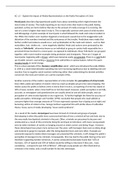AC 1.5 – Explain the Impact of Media Representation on the Public Perception of Crime
Moral panic describes disproportionate public fears about something which might threaten the
moral value of society. The media reporting on too much crime then leads to the public feeling
panicked, as they are led to believe that due to the amount of media coverage it is receiving, the
rate of a crime is higher than what it truly is. This is especially common with cases of child murders
and kidnappings. A prime example of moral panic is what followed the mods and rockers incident in
the 1960s; the media’s over-reaction triggered a moral panic caused due to the exaggeration and
distortion of the numbers involved and the seriousness of the trouble. Predictions were made that
further conflict and violence would occur, and symbolisation of the mods and rockers - such as their
motorbikes, hair, clothes etc. - were negatively labelled. Mods and rockers were portrayed by the
media as ‘folk-devils’, otherwise known as an individual or group in society held responsible for a
perceived threat involved in a moral panic. As opposed to individuals, these 'folk-devils' are grouped
together, with recent modern examples being protestors and immigrants. There are 5 stages of
moral panic, beginning with a threat, which soon becomes easily recognisable. There is a rapid build-
up of public concern, warranting a response from authorities or opinionmakers, before the panic
recedes/results in social change.
This is a clear example of the ‘deviancy amplification spiral’, which was introduced by Leslie Wilkins
in 1964 as a small initial deviation spiralling into ever increasing significance due to labelling and over
reaction. Due to negative social reaction reinforcing rather than undermining the deviant activities
concerned, the mods and rockers are a prime example of this.
Another outcome of the media’s representation of crime includes the perceptions of crime trends.
Since 2001, public perception of violent crime has crept up despite actual crime rates dropping. The
media causes the public to believe crime is worse than it truly is, as reporting of crime has stayed at
30% of news content, when crime itself has in fact decreased. However, public perception is not fully
accurate, as newspapers and questionnaires are usually aimed at and ask older people, and our
perception of crime trends depends on our region too. To further highlight the flaws the accuracy of
public perception, Schlesinger and Tumbler (1992) concluded that people who read tabloids or
consume higher than average amounts of TV have expressed a greater fear of going out at night and
becoming victims of violent crime. George Gerbner supported this with similar ideas of cultivation
theory, heavy users of media developing “mean world syndrome”.
As a result of the media, stereotypes have been formed of criminals and groups of people.
Stereotyping is when the public have a preconceived idea of how a criminal will act and look, due to
the way media has depicted criminals in the past. Often, criminals are presumed to be poor and
uneducated as a result of this commonly being the portrayal on television, with many young people
seen by older members of society as hanging around on street corners and being ‘thugs’. However,
these stereotypes have grown more serious over the years, with teenagers been seen as doing drugs
and involved in gangs for example, after this being depicted more and more often. If people are
constantly exposed to media where teenagers are presented like criminals, it will change the public’s
perception of teenagers to be criminals. Consequently, this may lead to the public fearing crime and
therefore supporting harsher sentences. A survey conducted by Barnados found that “65% of
Germans, 52% of Spanish and 50% of Italians would be willing to intervene if they saw... boys
vandalising... compared to just 34% of Britons”. Although young people are often illustrated as
criminals in the media, only a small number fit into this stereotype.





